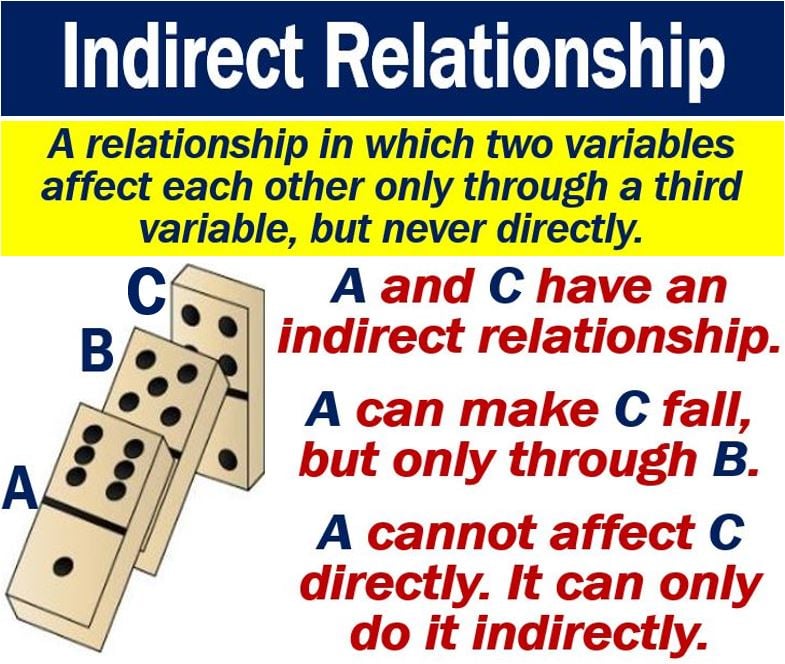An indirect relationship is a relationship between two variables which affect each other. However, they do not affect each other directly, but rather through a third variable. For example, Variable A affects Variable B, which affects Variable C. Variables A and C have an indirect relationship, i.e., through Variable B.
The two variables in an indirect relationship often move in opposite directions. In other words, when one moves up, the other moves down. They might, however, move in the same direction.
BusinessDictionary.com has the following definition of the term on its website:
“Groups 1 and 3 both interface with Group 2, but neither of them interfaces directly with each other.
“However, changes made by Group 1 which affects Group 2 could have an indirect effect on Group 3. This creates an indirect relationship.”

Inverse vs. indirect relationship
Although an inverse relationship, as well as an indirect relationship, may exist in the same situation, their meanings are not the same.
Inverse relationship
An inverse relationship, negative correlation, or inverse correlation is a contrary relationship between two variables.
In other words, the two variables move in opposite directions. For example, if Group 1 moves up, Group 2 subsequently declines, and vice-versa.
Whether there is another variable in the situation is irrelevant. In other words, inverse relationships may be either indirect or direct relationships. There may be three or just two variables present.
Let’s imagine there is a giant online retailer called NileRiverShop.com. It reported last week that the sales of diet products had increased. At the same time, sales of candy and chocolate had declined.
NileRiverShop.com added that it had noticed this pattern several times over the past five years. Sometimes, it happened the other way round. In other words, a change in the sales of candy/chocolate triggered a diet products movement in the opposite direction.
The retailer, therefore, concluded that diet products and candy/chocolate had an inverse relationship.
Interest rates and the inflation rate have an inverse relationship. If a country’s central bank raises interest rates, the inflation rate should start to decline.
In this context, interest rate refers to the rate at which the central bank lends to financial institutions. Inflation occurs when overall prices in an economy rise.
Indirect relationship
All this means is that one variable affects the another but through a third variable. They do not affect each other directly.
Group A affects Group B which affects Group C. However, Group A does not affect Group C directly.
We often use the term ‘indirect relationship’ for two variables that move in opposite directions, i.e., an inverse relationship.
So, what if one variable affects another variable through a third variable, and they both move in the same direction? In that case, there is an indirect but not inverse relationship.
Let’s imagine that the President of the United States met with the President of Russia. They did not speak each other’s language. Therefore, they communicated through an interpreter.
We can say that the two presidents had an indirect relationship. One could not make the other happy, angry, nervous, or anxious directly. They had to do it through a third party, i.e., the interpreter.
Some companies do not have a direct relationship with their customers. There is an agent who gets the business or acts as a go-between.
The supplier and customer, therefore, have an indirect relationship. Indirect relationships in business are common if the supplier and customer are in different countries.
